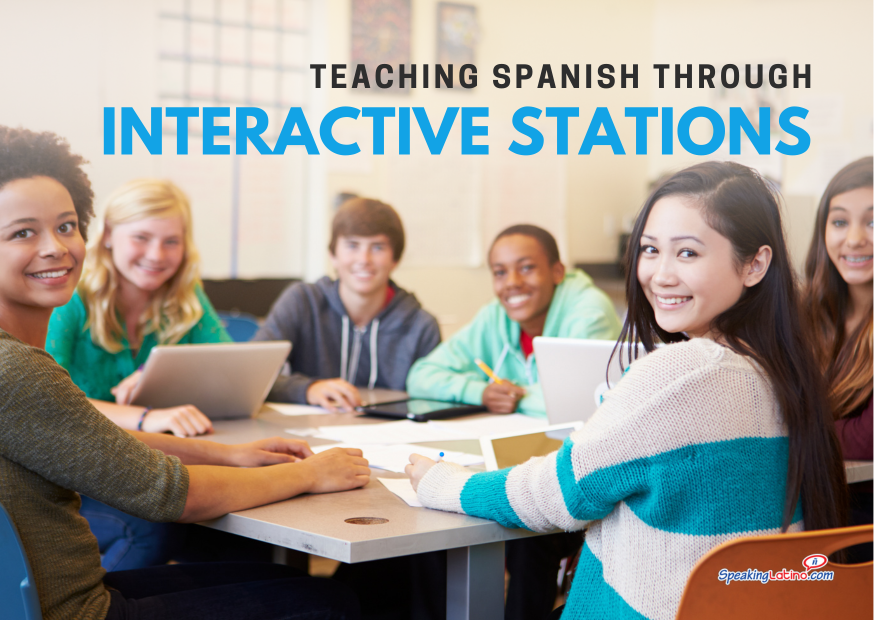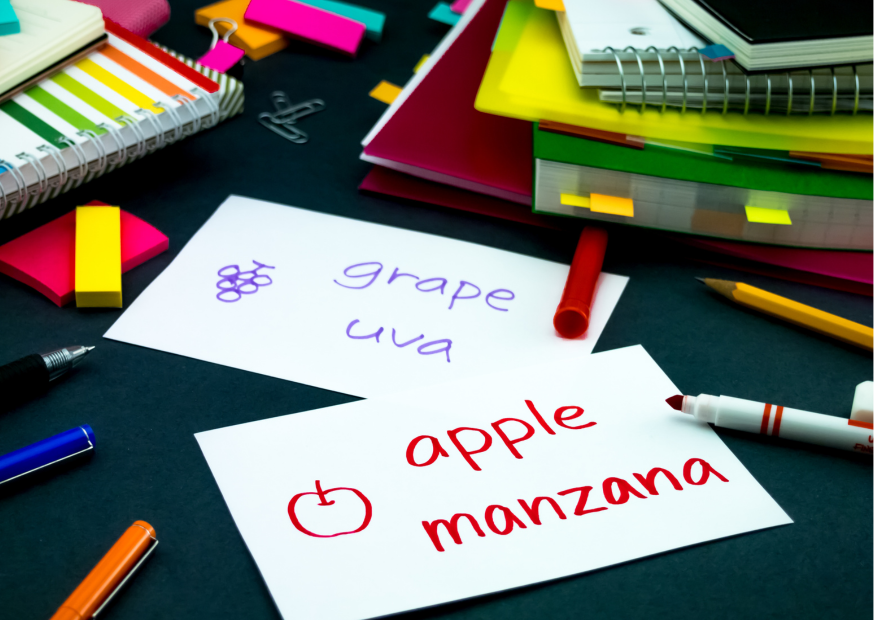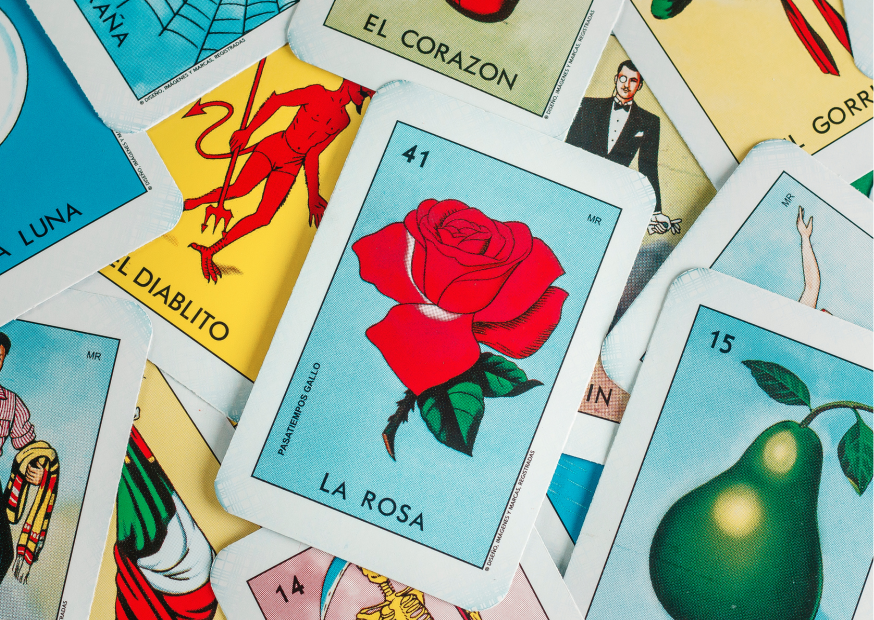
The content of this article is based on the presentation, How to Make Stations Work for You by Erinn Vincent, which was part of the World Language Teacher Summit.
Revolutionizing Spanish Learning with the Power of Interactive Stations
Embarking on the journey of language acquisition is an endeavor that is as complex as it is rewarding, calling for innovative teaching strategies that captivate students’ interests and meet diverse educational needs. Interactive learning stations stand as a testament to the transformative power of engaging, multi-sensory educational experiences.
By diverging from traditional instruction methods and embracing the interactivity of stations, learners are treated to an environment that promotes autonomy, engagement, and a tailored pace for language development. Let's present various station-based activities and games designed specifically for language learning and analyze their impact on vocabulary, grammar, reading, writing, comprehension, and conversational skills.
Vocabulary Enrichment Through Playful Interaction
Words serve as the building blocks of language and mastering them is essential to effective communication. Stations focused on vocabulary building blend fun with education, making the learning process enjoyable and memorable.
Activities such as a game of spoons using vocabulary cards, a scavenger hunt for new terms, and filling out Venn diagrams to contrast word meanings not only expand learners’ lexicons but also enhance their cognitive associations with the language. Games modeled after popular television shows introduce lively competition and further incentivize students to enrich their vocabulary bank.
Incorporating Pedagogical Games for Language Skills
Paralleling traditional games to educational goals maximizes both familiarity and fun, making it a perfect fit for language learning. For example, the use of dress-up and paper dolls can simulate cultural experiences and facilitate conversations in the target language. Web quests and image-based flashcards act as visual stimuli to strengthen recognition and recall, while recognized board games such as Jenga and Headbands serve as novel frameworks for practicing language in an interactive setting.
Grammar and Writing Proficiency at Focused Stations
Grammar is the framework upon which language rests, and its mastery is vital for clear communication. Stations that center around writing and grammar challenge students to roll dice for verb conjugations, assemble coherent sentences, and play disgust-themed vocabulary games to animate their writing skills.
By actively engaging in these structured yet creative activities, learners internalize the rules and nuances of grammar, enhancing their written and oral language abilities.
Supporting Independent Language Exploration
Stations enable students to navigate through the complexities of language at their own rhythm, fostering a sense of independence in their learning journey. Watching students independently negotiate meaning and utilize new language skills allows instructors to assess individual progress and offer tailored guidance.
The secret to the dynamic longevity of language stations is their consistent format augmented by variable content. This keeps the experience fresh for learners and allows educators to witness the unfolding of independent discovery and success.
Adaptability and Sustainability of Station Resources
An advantageous feature of language learning stations is their flexibility and reusable nature. Materials and instructions crafted for one project can easily be repurposed for subsequent projects. This adaptability affords the stations a sustainable character, thus maximizing the return on the investment of time and resources spent in preparation.
Enhancement Stations for Diverse Learning Needs
Language development is not one-dimensional; it requires attention to various aspects of learning. The incorporation of specialized stations, such as one dedicated to catch up on missed work, and stations that utilize technological resources like language apps and music, cater to both remedial and enrichment needs. It ensures that all students, regardless of their proficiency level, have access to materials and experiences that resonate with their learning pace and preferences.
Enriching Reading Comprehension Through Tailored Articles
Leveraging current bilingual news sources, educators can construct reading stations that bring authentic language content into the classroom. By focusing each station on different sections of the same article and assigning specific tasks, learners engage deeply with the text. This specialized attention ensures that students not only understand the material but also learn to analyze and discuss it, thereby enhancing their critical thinking skills in the language.

Stations focused on vocabulary building blend fun with education, making the learning process enjoyable and memorable
Facilitating Self-Assessment and Peer Review
Learning stations dedicated to writing provide an excellent platform for self-assessment and peer feedback. Drawing on rubrics aligned with authoritative language proficiency guidelines, students can self-identify strengths and opportunities for improvement in their work. This self-reflective practice fosters a classroom culture of assessment-capable learners.
Peer editing also enriches the assessment process, with partners giving feedback that transcends the traditional correction of grammar and spelling errors and instead focuses on content and structure.
FAQs About Stations
How can stations be effectively incorporated into a Spanish classroom to allow students to move at their own pace?
To effectively incorporate stations into a Spanish classroom and allow students to move at their own pace, several strategies can be implemented:
- Station Setup: Organize stations around different language skills such as vocabulary, grammar, reading, writing, listening, and speaking. Each station should focus on a specific task or activity related to the target language.
- Clear Instructions: Provide clear and concise instructions at each station to guide students on what they need to do. Include examples or models to support understanding.
- Varied Activities: Offer a variety of activities at different stations to cater to diverse learning preferences and styles. This can include games, puzzles, role-plays, multimedia resources, and hands-on tasks.
- Autonomy and Choice: Allow students to choose the order in which they visit stations based on their preferences or areas of improvement. This promotes autonomy and ownership of learning.
- Differentiated Tasks: Provide tasks of varying difficulty levels at different stations to accommodate students with different proficiency levels. This ensures that all students are appropriately challenged.
- Flexible Timing: Allow students to spend varying amounts of time at each station based on their needs. Some students may require more time to complete tasks or practice skills thoroughly.
- Monitoring and Support: Circulate around the classroom to monitor student progress, provide assistance when needed, and offer feedback on tasks completed at stations.
- Rotation System: Implement a rotation system where students move from one station to another at set intervals or when they have completed a task. This keeps the pace of the lesson dynamic and engaging.
- Reflection and Review: Incorporate time for students to reflect on their learning at stations and review their progress. This can include self-assessment activities or discussions on what they have learned.
- Integration with Curriculum: Ensure that station activities align with the curriculum objectives and learning outcomes. Stations should reinforce classroom instruction and provide opportunities for application of language skills.
By implementing these strategies, teachers can create a dynamic and student-centered learning environment that allows for personalized learning experiences and promotes language acquisition at varying paces.
What strategies can be utilized to give students autonomy and choice in their learning through stations?
To give students autonomy and choice in their learning through stations, the following strategies can be utilized:
- Station Selection: Allow students to choose which stations they want to visit based on their interests, learning goals, or areas of improvement. This empowers students to take ownership of their learning journey.
- Task Options: Provide students with a variety of tasks or activities at each station and let them choose which tasks to complete. This allows for personalized learning experiences tailored to individual preferences.
- Self-Paced Learning: Encourage students to progress through stations at their own pace. Some students may spend more time on challenging tasks, while others may move quickly through tasks they find easier.
- Choice of Materials: Offer students a selection of materials or resources to use at each station. This could include different types of texts, multimedia resources, manipulatives, or technology tools.
- Peer Collaboration: Allow students to work collaboratively with their peers at stations, giving them the choice to partner with classmates for certain activities. Collaboration promotes social interaction and shared learning experiences.
- Feedback Options: Provide students with choices for receiving feedback on their work at stations. This could involve self-assessment tools, peer feedback opportunities, or teacher-guided feedback sessions.
- Reflection Activities: Incorporate reflection activities at the end of station rotations where students can reflect on their learning, identify areas of growth, and set goals for future learning.
- Task Customization: Allow students to customize tasks or activities at stations to align with their learning preferences or strengths. This could involve modifying tasks to make them more challenging or engaging.
- Learning Contracts: Implement learning contracts where students set goals, choose activities to work on, and track their progress at stations. This promotes accountability and self-regulation in learning.
- Choice Boards: Create choice boards or menus that outline different station activities and allow students to select tasks from the menu. This provides a structured way for students to make choices within the station framework.
By incorporating these strategies, teachers can foster a sense of autonomy, independence, and personalization in student learning through stations, leading to increased engagement and motivation in language acquisition.

Web quests and image-based flashcards act as visual stimuli to strengthen recognition and recall
What are some creative station ideas that can be implemented to make language learning more interactive and enjoyable?
Here are some creative station ideas that can be implemented to make language learning more interactive and enjoyable in the classroom:
- Conversation Cafe: Set up a station where students can engage in casual conversations in the target language. Provide conversation prompts, role-play scenarios, or discussion topics to encourage speaking practice.
- Interactive Vocabulary Games: Create vocabulary stations with interactive games such as word puzzles, flashcard matching activities, or vocabulary bingo. These games can make vocabulary practice more engaging and fun.
- Culture Corner: Design a station focused on exploring the culture of the target language. Include activities like watching short cultural videos, reading about traditions, or trying out cultural crafts or recipes.
- Storytelling Station: Set up a station where students can create and share their own stories in the target language. Provide story prompts, picture cards, or story cubes to inspire creativity and language production.
- Listening Lounge: Create a listening station with audio clips, podcasts, or songs in the target language. Students can listen to authentic language materials and complete listening comprehension activities.
- Grammar Games Galore: Develop stations with grammar-focused games such as grammar jeopardy, grammar tic-tac-toe, or grammar escape rooms. These games can make grammar practice more interactive and engaging.
- Digital Discovery: Incorporate digital stations where students can interact with language learning apps, online resources, or multimedia platforms. This can add a tech-savvy element to language learning and cater to digital learners.
- Role-Play Station: Set up a station for role-playing scenarios related to real-life situations like ordering food in a restaurant, booking a hotel room, or asking for directions. Role-plays can enhance speaking and communication skills.
- Creative Writing Corner: Create a station for creative writing activities such as writing poems, short stories, or dialogues in the target language. Encourage students to express themselves creatively through writing.
- Mystery Puzzle Challenge: Design a station with mystery puzzles or riddles in the target language. Students must solve the puzzles by using language skills like decoding, inference, and critical thinking.
- Virtual Travel Station: Take students on a virtual travel experience through a station where they explore different countries and regions where the target language is spoken. Include virtual tours, cultural facts, and language activities related to each destination.
By incorporating these creative station ideas into language learning activities, teachers can make the learning process more interactive, enjoyable, and effective for students of all proficiency levels.
Interactive Stations to Ignite Passion for Language Learning and Foster Student Autonomy
Language learning stations herald a paradigm shift from the conventional didactic teaching model to one that is student-centered, interactive, and multidimensional. By incorporating a diverse range of activities and feedback procedures, the approach facilitates active, autonomous learners who are equipped to tackle the myriad facets of language. This method not only nurtures linguistic skills across the spectrum—from vocabulary acquisition to communicative competence—but also kindles a love for the language that extends beyond the classroom walls.
Interactive learning stations deliver an enriched educational landscape that promises to engross students and foster sustained language growth throughout their academic voyage.
Discover more language teaching techniques to help you in your classroom.